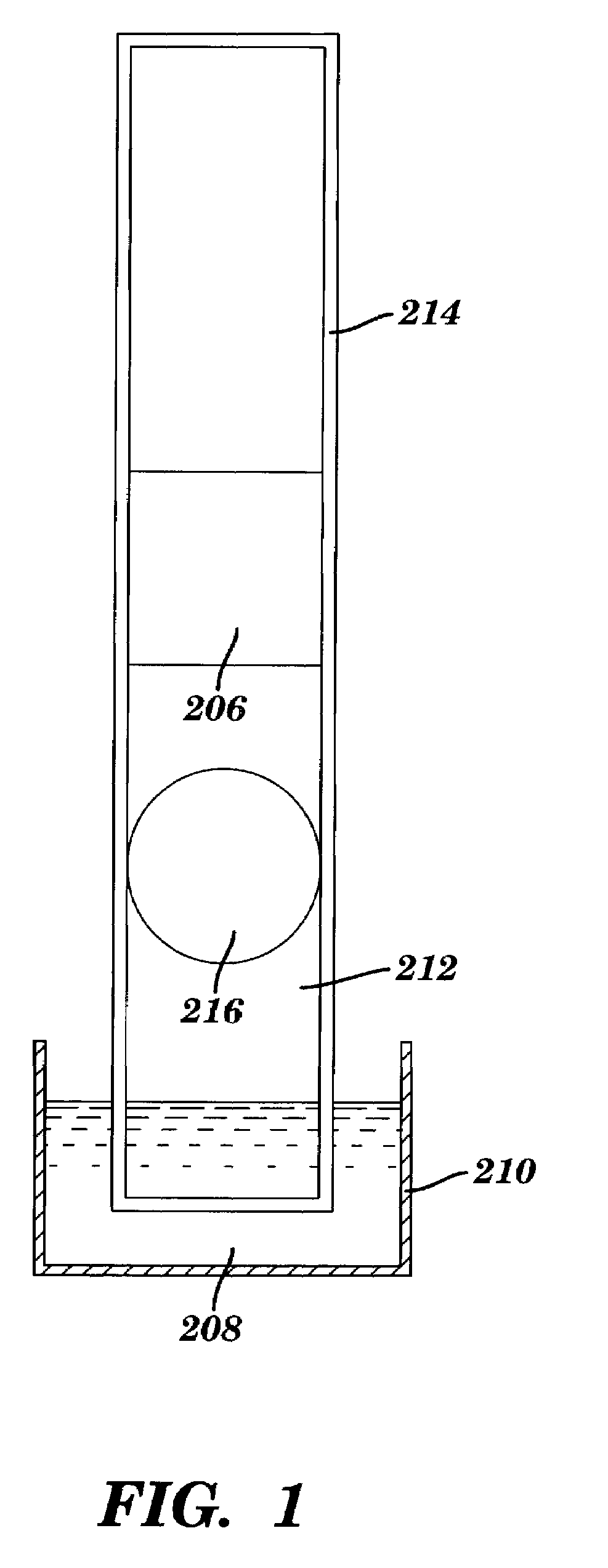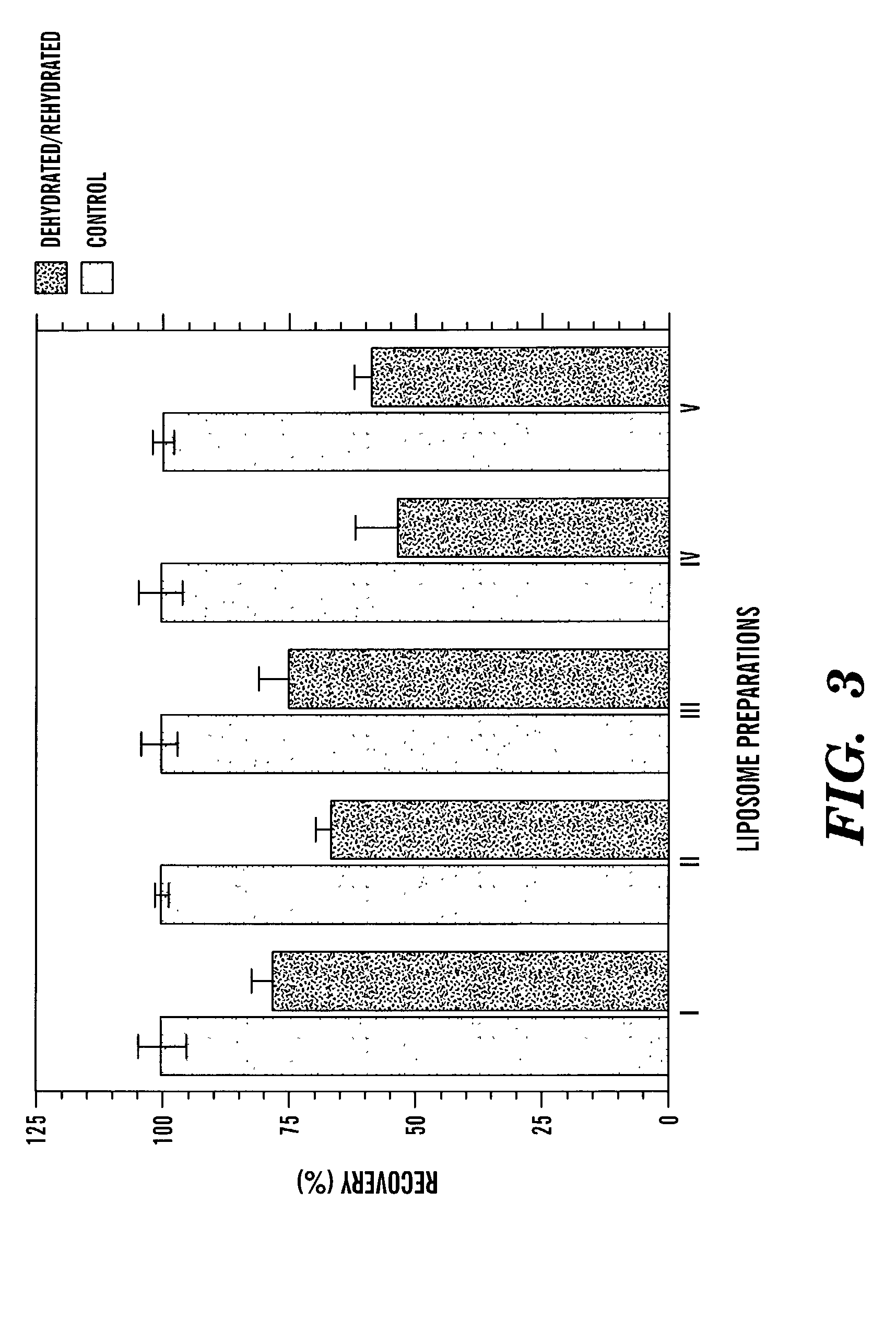Method of making a test device
a test device and test tube technology, applied in the field of making test tubes, can solve the problems of long time required for antigen-antibody reaction, and achieve the effects of reducing aggregation, improving recovery rate, and improving intensity
- Summary
- Abstract
- Description
- Claims
- Application Information
AI Technical Summary
Benefits of technology
Problems solved by technology
Method used
Image
Examples
example 1
Materials
[0086]Dipalmitoyl phosphatidyl choline (DPPC) and dipalmitoyl phosphatidyl glycerol (DPPG) were obtained from Avanti Polar Lipids, Inc. (Alabaster, Ala.). Sulforhodamine B (SRB), N-((6-(biotinoyl)amino)hexanoyl)-1,2-dihexadecanoyl-sn-glycero-3-phosphoethanolamine, triethylammonium salt (biotinylated DPPE), and D(+)-biotin were purchased from Molecular Probes (Eugene, Ore.). Polyvinylpyrrolidone (PVP, 10,000 Da), cholesterol, normal human serum (NHS), gelatin, bovine serum albumin (BSA), sucrose, trehalose, Tris(hydroxymethyl)aminomethane (Tris), Tween 20, and Sephadex G-50 were purchased from Sigma Chemical Co., (St. Louis, Mo.). Carnation brand nonfat dry milk (NFDM) was acquired locally. Polycarbonate syringe filters of 3-, 0.4-, and 0.2-μm pore sizes were purchased from Osmonics Laboratory Products (Livermore, Calif.) and Mylar-supported nitrocellulose membranes with 8-μm pore size were obtained from Sartorius Corp. (Goettingen, Germany) and Millipore Corp. (Bedford, Mas...
example 2
Preparation of Biotin-Tagged, Dye-Loaded Liposomes
[0087]Five batches of liposomes, labeled I to V, were prepared to study the stabilizing effect of sugar (trehalose) inside the liposomes. The batches were prepared by a modified reverse-phase evaporation method (Siebert et al., Anal. Chim Acta, 282:297-305 (1993); Szoka et al., Biochim. Biophys. Acta, 601:559-571 (1980); O'Connell et al., Clin. Chem., 31:1424-1426 (1985, which are hereby incorporated by reference) from a mixture of DPPC, cholesterol, DPPG, and biotinylated DPPE in a molar ratio of 4.7:4.8:0.5:0.01. In the lumen of the liposomes was encapsulated the same concentration of sulforhodamine B (100 mM), increasing amounts of trehalose. and decreasing amounts of Tris / (hydroxymethyl)aminomethane / HCl (Tris / HCl) buffer, pH 7.0, to maintain an osmolality value of 827 mOsmol / kg for each preparation (see Table 1).
[0088]
TABLE 1Biotin-Tagged Liposome CharacteristicsLiposome preparationIIIIIIIVVVIVIIVIIIMean diameter* (nm)32135329437...
example 3
Characterization of the Liposomes
[0091]The mean diameter of the liposomes was measured by a laser-based light-scattering particle-size analyzer (PCS sizing system from Malvern Instruments Ltd, Malvern, UK). Fluorescence intensity measurements were carried out on a McPherson Model SF 750 spectrofluorometer (Acton, Mass.) operated at excitation and emission wave-lengths of 543 and 596 nm, respectively.
PUM
| Property | Measurement | Unit |
|---|---|---|
| temperature | aaaaa | aaaaa |
| temperature | aaaaa | aaaaa |
| concentrations | aaaaa | aaaaa |
Abstract
Description
Claims
Application Information
 Login to View More
Login to View More - R&D
- Intellectual Property
- Life Sciences
- Materials
- Tech Scout
- Unparalleled Data Quality
- Higher Quality Content
- 60% Fewer Hallucinations
Browse by: Latest US Patents, China's latest patents, Technical Efficacy Thesaurus, Application Domain, Technology Topic, Popular Technical Reports.
© 2025 PatSnap. All rights reserved.Legal|Privacy policy|Modern Slavery Act Transparency Statement|Sitemap|About US| Contact US: help@patsnap.com



